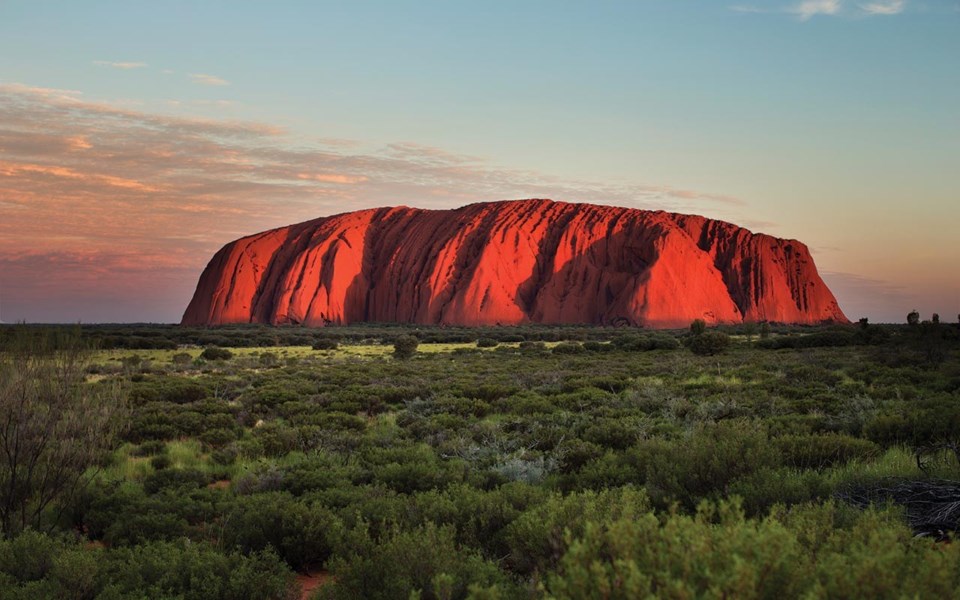One of the fundamental lessons I learned as a kid was "Look, don't touch." Don't smear your gross kid fingers on the glass at the aquarium. Don't lay one hand on that very expensive-looking motorcycle parked out front of the local pub. And whatever you do, don't be reaching into that hot oven just because the contents look delicious.
While I may have occasionally objected to these seemingly unfair rules at the time, I came to know they were in place for good reason. In some cases it was for my safety, but mostly it was about showing consideration to others and respect to the owners of the interesting thing I was pointing at.
Consideration and respect. Two things not shown at one of Australia's most sacred Indigenous sites in recent years.
One of the defining images of Australia is the Red Centre in the heart of the Northern Territory Outback. The massive sandstone monolith Uluru (formerly known as Ayers Rock) is the centrepiece of this unique region and its deep crimson colour and prominence over the surrounding desert has long made it an icon of Australian tourism marketing.
Some quick historical context. The western name was given by British surveyor William Gosse in 1872 after he "discovered" the monolith and named it Ayers Rock after the former chief secretary of South Australia, Sir Henry Ayers. The rock was declared a part of Ulur_u-Kata Tjut_a National Park in 1958 (Kata Tjut_a is a neighbouring series of domed rock formations). The Aboriginal Land Rights Act was passed in 1976, finally recognizing traditional ownership by the indigenous An_angu people of Central Australia. In 1993, Uluru became the first icon in Australia to be given back its Aboriginal name.
For decades, tourists from other parts of Australia—and the world—have journeyed to the Red Centre to see Uluru and for decades, the An_angu have urged tourists not to climb on their sacred site. But people being people, they climbed it anyway.
The top of Uluru stands at 863 metres above sea level with 344 metres of prominence above the land around it. There is a chain linking 12 iron postings which acts as a climbing aid in the rock, but that's it. At least 35 people have died over the years while attempting the ascent (or descent) and hundreds more have injured themselves with broken bones, heat exhaustion and extreme dehydration.
Safety concerns aside, the traditional owners liken climbing on Uluru as people scaling up onto a church or the statue of a respected elder or statesman. The rock holds immeasurable cultural value to the An_angu, yet despite clear signs at its base explaining the traditional law not to climb it (in six languages), the tourists just couldn't help themselves. So two years ago, the traditional owners voted to ban climbing Uluru altogether. That ban was finally enacted on Oct. 26, 2019.
Over the last few months, the approaching deadline saw a rush of tourism to Uluru and many were Australians. Last week, the newswires lit up with photos and videos of hundreds of people in the queue to climb the rock, not unlike a Saturday morning Joffre Lakes conga line. When journalists asked these tourists why they chose to climb, some were casually self-aware of their innate disrespect but many simply saw it as their entitled right.
Some of the most ludicrous statements I heard in these radio interviews:
"I thought it would be a great view from the top and a very interesting experience to tick off the bucket list. While it is a sacred place to (to the An_angu), we don't live under their traditional law."
"It's part of Australia, and we're all Australians."
"I respect the culture, but..."
"It's a rock. It's meant to be climbed."
Whether inherently uncivil or just plain ignorant, these colonialism attitudes are shameful and mirror a deep-seeded self-regard that permeates contemporary outdoor tourism. At what point is your own recreational experience worth insulting the culture that his hosting that experience for you?
I personally haven't visited the Red Centre yet, but I'm glad that visiting tourists are now forced to appreciate Uluru from afar. There are plenty of other prominent landmarks to climb in Australia that aren't sacred Indigenous sites. Hopefully the climbing ban makes the interpretive experience that much more valuable for future visitors.
Vince Shuley occasionally feels the need to check the behaviour of his countrymen. For questions, comments or suggestions for The Outsider email vince@vinceshuley.com or Instagram @whis_vince.




